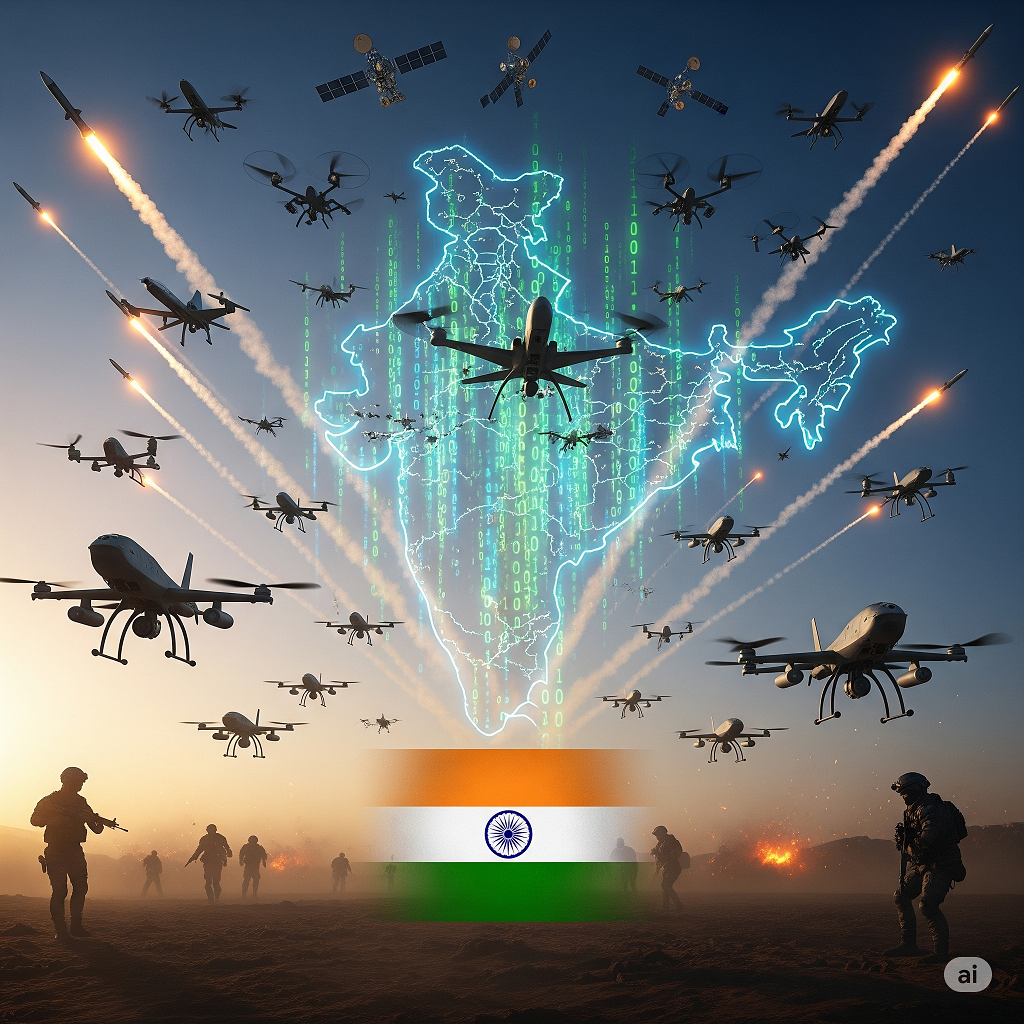
- In today’s world, real power lies not just in having stockpiles of missiles or money, but in the ability to respond to a crisis and the wisdom to communicate with clarity.
- Future wars will be fought on six domains – Land, sea, air, information, cyberspace, and space.
- A successful drone operation will create fear psychosis in society and lead to a lack of confidence in the armed forces and the government.
- India should reorient its forces and society to face new threat vectors that have emerged to defend its sovereignty.
After 12 days of bloodshed, the latest episode in the Middle East played out as predicted in Part 1 of this two-part series. Lack of strategic depth (Israel) and regime preservation (Iran) were stark realities that forced arch enemies to agree to a truce. A truce declared may also be a ruse: one that merely gives each side a chance to catch its breath and prepare for new provocations. As the axis of global power slowly shifts from the North Atlantic to the Asia Pacific zone, the world has entered an era of conflicts wherein old faultlines will be revisited and new ones formed. India, a nation navigating complex geopolitical faultlines with hostile neighbours, cannot ignore the tectonic shifts that are resulting in conflict with neighbours. In the final part of this series, the lessons that India can draw from the conflict are presented.
Disruptive Drone Technologies: A new wave of weapon systems based on disruptive technologies has changed the landscape of war forever. Drones (land, air, and sea) in all their manifold avatars (recce, combat, FPV, etc.) and cyber warfare have blurred the line between front and rear, or combatant and non-combatant. The barrier to entry for advanced drones is falling. Precision-guided weapons, once exclusive to great powers, are now accessible to middle and even smaller states, putting countries like India at risk. Though India has embarked on the drone journey, it is yet to harmonise it to the platoon level (the smallest war-fighting component). Constantly evolving technologies render the pre-war fighting procurement process redundant. India should demonstrate flexibility and agility in its procurement to keep up with the technology curve. It is time to consider a separate command for Drones to provide a centralised structure and consolidate training and expertise. Similarly, Legal avenues to stop the proliferation of drones near sensitive installations must be explored to safeguard national assets. A successful drone operation behind the front lines could create fear psychosis in society and lead to a lack of credibility towards the armed forces/government.
Atma Nirbar: The conflict showcased the limitations on a country’s sovereignty if it is not self-reliant. Israel, for all its vaunted military powers, had to turn to the US to inflict damage on hardened nuclear plants at Fardo,w and Natanaz. Ovthe er the last decade, India has embarked on a national mission of self-reliance and achieved good success. However, we are still dependent on key platforms such as fighter aircraft, precision weapons, submarines eton India should increase its R&D budget, encourage private industry participation and ensure that ensure that we are truly Atmanirbar across the spectrum within the next 5 to 10 years timeframe.
The key to sustaining conflicts is redundant supply chains and adequate strategic reserves. The 12-day conflict has exposed India’s external vulnerabilities, particularly in energy security and trade logistics. War resulted in rising freight costs, disrupted trade routes through the Strait of Hormuz, and volatility in crude oil markets, which pose immediate challenges to India’s inflation management and current account stability. India needs to relook at its lopsided energy consumption and move strategically towards lowering dependency. In the near to mid-term, strategic reserves storage capacity (Oil/Gas) needs to be built up.
Dual Use Industries: A developing country like India can ill afford to spend more than 3% of its GDP on defence. India should look at dual-use industries strategically to ensure that defence assembly lines that manufacture dual-use products can quickly and seamlessly manufacture military goods when needed during times of conflict. Case in point is the ease with which automobile companies can use their assembly lines to mass manufacture drones.
Robust Intelligence: This conflict proved the adage of intelligence being a force multiplier. Mossad (Israeli Intelligence Agency) infiltrated Iran and used proxies to deliver devastating drone strikes from within on 13 Jun, which paralysed the Iranian AD network. The operation showed a sense of purpose, commitment spanning years and political will. India should harness the capability to undertake such complex missions by deepening military-intelligence integration and enhancing our offensive and covert capabilities to undertake such complex missions. India as a nation has many faultlines that have been exploited by our enemies for decades to bleed us slowly. With this new technology, the danger presented by these covert operations has reached stratospheric levels. Without real-time actionable intelligence, there is no defence against such attacks due to very low reaction times. Indian counter-intelligence units need to rework their procedures, sensitise agents on this emerging danger and work towards mitigation.
Operationalise Multi-Domain warfare: Days of fighting wars by kinetic means have gone by. Future wars will be fought on six domains – Land, sea, air, information, cyberspace, and space. War isn’t just about firepower. Cyberattacks crippled radars, disrupted hospitals, and glitched city systems. Mossad ran a secret drone base inside Iran, and the war kicked off with the suspected assassination of an Iranian general. It’s no longer just tanks vs tanks, a relic of the past two World Wars. It’s now hackers vs. utility grids, leaked audio vs. morale, and drone swarms vs. deniability. In this kind of fight, the battlefield is everywhere — online, underground, and inside your head.
In modern hybrid warfare, missiles will fly, but minds and markets are targets too. India must achieve synergy across all six domains and take control of the narrative. It should leverage owned media — websites, newsletters, and social platforms — to control the narrative, rather than allowing adversaries to do so.
Wars are no longer just tanks vs tanks, a relic of the past two World Wars. It’s now hackers vs. utility grids, leaked audio vs. morale, and drone swarms vs. deniability. The battlefield is everywhere — online, underground, and inside your head.
Redundancy in Command & Control: Despite our best efforts, we may lose our command-and-control structures. India should plan and ensure that command and control redundancy structures are tested and in place. Iran was able to come out of decapacitation strikes as it had the necessary redundancy structures in place. This applies to both military as well as civilian domains. A second important lesson that this conflict teaches is that decapitation strikes don’t result in victory. Israel took out the cream of the Iranian republican guard, but that didn’t result in a victory. India too faces state-sponsored terrorist groups in its neighbourhood, and taking out terrorist leaders will only give us a reprieve, but not solve the root cause. India should not lower its guard and ensure that the huge costs are inflicted on the enemy state apparatus that promotes terrorists against it.
Emergency Services: The conflict showcased the devastation that modern firepower can bring to a society. India should reinforce its emergency services to handle an all-out conflict. Prepare civil society to accept that losses to life and property are a reality in modern warfare. Good and efficient emergency services are a huge moral booster.
Quantity: Iran used saturation strikes to overload the famed Israeli AD network and wreak havoc in Tel Aviv and Haifa. Stalin’s quote of “Quantity has a quality all its own” was proved all over again. Low-cost Shaheed drones were launched en masse to ensure that some got through. India, in its quest for hi-tech equipment, should not lose sight of this metric. A judicious mix of quantity and quality is the way forward for a developing country like India.
International Agencies: Conflict once again brought to the fore either the helplessness (UN) or the bias (IAEA) of international agencies. India has signed safeguards agreements with the International Atomic Energy Agency (IAEA) for its civilian nuclear facilities, with the agreement for the application of safeguards to civilian nuclear facilities that came into force in 2009. The US and the West use these international agencies to monitor and bring countries under their influence. The selective cooperation of the US with the ICC (International Criminal Court) has faced ridicule across the world. India needs to bring in a strong framework to rein in the work of international agencies/NGOs and ensure that their work is not detrimental to the nation’s interests.
No Holy Cow: Iran-Israel conflict obliterated all written and unwritten laws of ethical warfare. Assassination of nuclear scientists, audio calls to kill the family of an Iranian general, and attacks on each other’s nuclear sites were all part of warfare. As the UN stood helpless, these attacks were normalised. India, with its strong moral compass, will become an outlier in this world. India should recognise the change in warfare norms and harden its strategic assets in the near to mid-term. India, along with the Global South, should use diplomacy to further the cause of UN reforms.
Complex Neighbours: Israel was helped by friendly air forces from Jordan, Iraq and the West in countering the Iranian drone threat. India is situated in a complex neighbourhood wherein alignment of forces against it cannot be ruled out. China is reportedly planning to construct or revive an airfield in Lalmonirhat, Bangladesh, located in its north near India’s border, and the strategically sensitive “Chicken’s Neck” comes to mind. Transfer of technology from China to Pakistan is also a cause for concern. India should be alert to any such devious plans and make diplomatic and trade agreements to counter them.
Conclusion
The Israel-Iran war was driven by identity and ideology – forces that continue to shape conflicts in the modern world. India, too, faces similar challenges in its neighbourhood. While the country has made significant strides in modernising its armed forces over the past decade, the Middle East conflict serves as a stark reminder: future wars may not begin with boots on the ground. This was a battle fought not only with missiles and bombs, but also with bots, disinformation, and shadowy proxies. In today’s world, true power lies not merely in stockpiles of weapons or reserves of wealth, but in the agility to respond decisively to crises and the wisdom to communicate with clarity and purpose. India must reorient both its military strategy and societal mindset to confront these evolving threats and defend its sovereignty.
Wing Commander Rajeev KS (Retired) is a seasoned ICT professional with 23 years of expertise in IP/MPLS networks, tactical communication, VoIP, data centre technologies, solution design, and program management across aerospace and defence sectors. He can be reached at raaka08@gmail.com. Views expressed are the author’s own.
